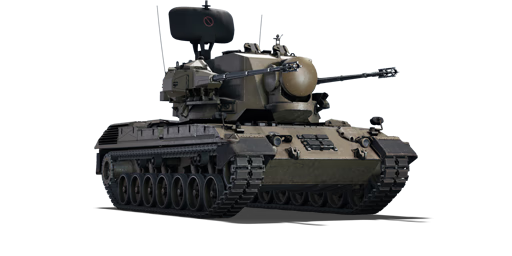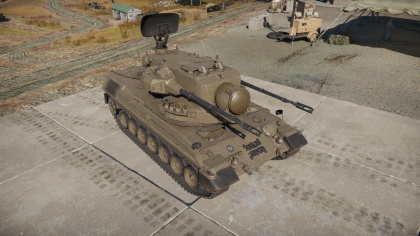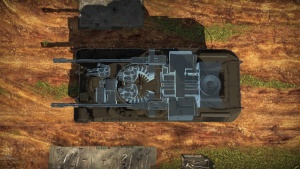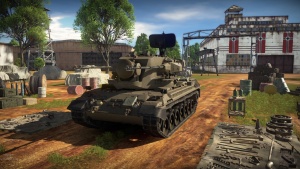Gepard
Contents
Description
The Flakpanzer I Gepard is a rank VI German Self-Propelled Anti-Aircraft (SPAA) vehicle
with a battle rating of 8.3 (AB/RB/SB). It was introduced in Update 1.63 "Desert Hunters". An anti-aircraft vehicle based on the Leopard 1 chassis, it possesses 2x35mm Oerlikon KDA cannons with 340 rounds each (680 in total, in 2 continuous belts of ammunition, one for each cannon). As in real life, the Gepard is equipped with a radar that can track and calculate the lead necessary to effectively engage a target. This is represented in the game by the ability to lock onto a target and display an arcade-style lead indicator on the target when they are within effective range, a trait that all radar-guided SPAAs possess. This allows the 35 mm cannons, which have a tendency to cripple enemy plane and helicopters alike with a hit, to maximize its damage potential.
General info
Survivability and armour
Common among almost all SPAAs, the Gepard's armour can only withstand heavy machine guns and aircraft cannons and such, even other SPAAs and light tanks will pose a threat. Having 30mm of armour at its thickest point, in the game, the Gepard can be hull broken by shells of a calibre of 75mm and higher.
The Gepard has a crew of 3, consisting of a gunner, a commander and a driver with the first 2 residing in the turret and the third in the hull. The ammunition is stored in its entirety in the turret basket, below the crew; in practice, the Gepard is rarely ammo racked, and most often it is your crew that will be knocked out or the tank being burned down by chemical munitions fired from enemy aircraft that it faces, such as helicopters and jet attack aircraft which are both a threat and a tricky target.
Armour type:
- Rolled homogeneous armour
| Armour | Front | Sides | Rear | Roof |
|---|---|---|---|---|
| Hull | 30 (59°) Front glacis 30 mm (48°) Lower glacis |
25 mm (40-41°) Top 20 mm Lower |
20 mm (6°) Top 20 mm (49°) Bottom |
30 mm Driver/Co-driver port area 15 mm Everywhere else |
| Turret | 25 mm (1-30°) | 20 mm Turret side 10 mm Cannon mounts |
20 mm (3°) | 15 mm |
Mobility
| Game Mode | Max Speed (km/h) | Weight (tons) | Engine power (horsepower) | Power-to-weight ratio (hp/ton) | |||
|---|---|---|---|---|---|---|---|
| Forward | Reverse | Stock | Upgraded | Stock | Upgraded | ||
| Arcade | 71 | 28 | 46 | 1179 | 1,584 | 25.63 | 34.43 |
| Realistic | 66 | 26 | 734 | 830 | 15.96 | 18.04 | |
Having the chassis of the Leopard 1, the Gepard is almost identical in mobility to the MBT, possessing the same engine power, making it useful at capturing zones and getting out of harm's way.
Its top speed is 57 km/h forward and -22 km/h backwards, with acceleration time and neutral steering speed depending on the installed modules.
Armaments
Main armament
The armament consists of 2x35mm Oerlikon KDA cannons with 340 RPG with a quick, fixed fire rate and can make use of 3 types of munitions :
- High-explosive incendiary tracer (self-destroying, note that the self-destruction range coincides with the radar's lead indicator maximum distance, making the shell inadequate at longer ranges)
- Armour-piercing incendiary tracer, which can be used against lightly armoured vehicles and enemy SPAAs, though the damage to enemy aircraft is reduced, the shell can be used outside radar range since it does not self destruct
- High-velocity armour-piercing tracer (APDS), which can be used against targets mentioned above and additionally, can be used to attack the side profile of enemy MBTs with reasonable effectiveness. Use against air targets is possible but the damage output is highly reduced.
| 35 mm Oerlikon KDA cannon (x2) | Turret rotation speed (°/s) | Reloading rate (seconds) | ||||||||||||
|---|---|---|---|---|---|---|---|---|---|---|---|---|---|---|
| Mode | Capacity (Belt) | Fire rate | Vertical | Horizontal | Stabilizer | Stock | Upgraded | Full | Expert | Aced | Stock | Full | Expert | Aced |
| Arcade | 680 (340) | 550 | -10°/+85° | ±180° | Two-plane | 79.3 | __.__ | __.__ | __.__ | __.__ | 1.3 | _.__ | _.__ | 1 |
| Realistic | 53.5 | __.__ | __.__ | __.__ | __.__ | |||||||||
Ammunition
| Ammunition | Belt Composition |
Penetration in mm @ 90° | |||||
|---|---|---|---|---|---|---|---|
| 10m | 100m | 500m | 1000m | 1500m | 2000m | ||
| Default | API-T, HEI-T* | 67 | 64 | 52 | 39 | 30 | 23 |
| 35x228 MSB/K | HEI-T*, HEI-T*, HEI-T*, API-T | 67 | 64 | 52 | 39 | 30 | 23 |
| 35x228 PSBH/B | API-T, API-T, API-T, HEI-T* | 67 | 64 | 52 | 39 | 30 | 23 |
| 35x228 PKLH | APDS, APDS, APDS, APDS | 112 | 110 | 101 | 90 | 71 | 62 |
Belt types
| Belts | Shell composition | Combat usage |
| Default | API-T — HEI-T* | |
| Sprgr. | HEI-T* — HEI-T* — HEI-T* — API-T | |
| PzGr | API-T — API-T — API-T — HEI-T* | |
| PzGr 40 | APDS — APDS — APDS — APDS |
Ammo racks
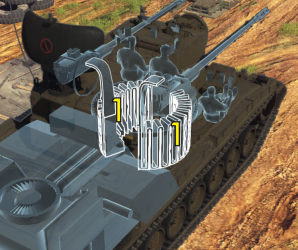
| Full ammo |
1st rack empty |
Visual discrepancy |
|---|---|---|
| 680 | 0 (+680) | no |
Rack empties when all rounds are spent
Radars
The Gepard is equipped with a MPDR 12 search radar and an Albis tracking radar. Both radars are located on the turret, the MPDR 12 is mounted at the rear of the turret and folds back when not in use, the Albis is mounted on the front of the turret. The radar system is capable of tracking a target while scanning, but can only track targets within a 200° arc from the front of the turret.
| MPDR 12 - Target Detection Radar | ||||
|---|---|---|---|---|
| Maximum Detection Range |
Minimum Detection Range |
Max Azimuth Scan Angle |
Max Elevation Scan Angle |
Minimum relative speed |
| 15,000 m | 500 m | 360° | ??? | 10 m/s (36 km/h) |
| Albis - Target Tracking Radar | ||||
| Maximum Tracking Range |
Minimum Tracking Range |
Azimuth Tracking Angle |
Elevation Tracking Angle |
Minimum target speed |
| 15,000 m | 75 m | ±100° | -20°/+85° | 15 m/s (54 km/h) |
Usage in battles
The Gepard performs best when stalking enemy aircraft, scanning the sky for a target and waiting until it gets in range of the radar, and only attacking when the radar can provide a lead estimation, thus preserving ammunition which is critical since the cannons will expend it quickly in combat situations. Helicopters will more than often chose to keep a reasonable distance, usually outside your radar's range but this can be countered by using the API-T rounds in short burst until the range of the enemy has been deduced, it only takes a few rounds to destroy an enemy aircraft.
Engaging ground vehicles comes with the risk of being destroyed without doing any significant damage so weigh your options carefully, unsuspecting light tanks are fair game but most tanks will pose a threat even when attacking their side without the appropriate ammunition belts.
Capturing points is also an option thanks to the good mobility of the vehicle, although you will have to make sure the capture point is clear and there is no risk of being attacked by an enemy tank.
Against enemy threats:
- Arcade: Keep your head on a swivel, and when enemies start air battles be prepared to react very soon; jets can reach the battle in seconds. Try to fire as soon as the enemy reaches within 2 kilometres, any closer and you risk the aircraft being able to open fire on you or even ram you and induce Hull Break. Helicopters should be treated with a similar deal of respect, so try to limit the amount of time they have within firing range by coating them in a blank of anti-air fire as soon as the lead indicator appears.
- Realistic/Simulator: If using the Gepard in higher rank games, be mindful of aircraft such as the AH-1Z and FJ-4B VMF-232. Their long-range guided missiles allow them to attack you outside of the range of your lead indicator or even out of the range of your guns themselves. Stay hidden until they draw closer, and then attempt to "ambush" them as they are pre-occupied attacking other allies. Stay away from common traffic areas if your only goal is to take out these aircraft, and try to sneak as close as possible to them so that you can re-acquire the lead indicator. Thanks to the fact the Gepard is vulnerable to being Hull Broken, it only takes a missile landing near to completely disable the anti-aircraft vehicle.
Pros and cons
Pros:
- Has the mobility of the Leopard tank, though the increased weight is noticeable
- Very fast turret rotation
- Good stock grind thanks to its already good gun handling
- Can penetrate many tanks from the side even with its default belt
- High penetration with DM23 belt that is also cheaper to restock than other belts
- Twin 35 mm cannons are very deadly against both aircraft and tanks with a high rate of fire and accuracy
- Has stabilizer - can shoot targets while on the move, air and ground ones alike
- Good amount of ammo in reserve
- Search and tracking radars, the search radar finds targets while the tracking radar gives a very accurate lead indicator
- Search radar dish can be folded when not in use to reduce vehicle height and visibility
- Low repair cost in RB and SB
- Low spawn point cost in RB
Cons:
- Relatively high profile, and a spinning radar dish atop the vehicle
- Very thin armour that can be easily destroyed with hull-break
- Cannons are mounted on the sides of the turret that can make shooting weak spots at close range almost impossible
- Relatively low rate-of-fire compared to the M163 and ZSU-23-4
- Incredibly long reload time when all ammo is expended
- Can only take 40 x DM23s to battle, must be fired very carefully
- Expensive unlockable ammo belts (except the DM23 belt)
- High repair cost in AB
History
Development
Development began on a dedicated self-propelled anti-aircraft gun for the German Bundeswehr in the 1960s. The first pilot models were produced in 1969 testing 30 and 35 mm autocannons for the armament. The decision to use a 35 mm autocannon as the basis of the anti-aircraft armament came on 25 June 1970. In 1971 the second phase of pilot models was tested, the Dutch Army expressed interest in the project and ordered a few models once completed. It was around this phase that the Leopard 1 was chosen as the chassis of the vehicle, and a modified variant was produced. In September 1973, the order was made to Krauss-Maffei manufacturer to produce 432 turret and 430 hulls. The Bundeswehr accepted the vehicle as to the Flugabwehrkanonenpanzer Gepard (Anti-aircraft cannon tank "Cheetah"), or better known as the Flakpanzer Gepard. At least 430 Flakpanzer Gepard units were produced in total from 1973 onwards.
Design
The Flakpanzer Gepard uses the 35 mm Oerlikon KDA autocannon, which was a dual-mounted cannon that each can fire around 550 rounds per minute. The Gepard has a search radar on the back, a tracking radar in front, and a laser range finder in the front to track air targets. The Flakpanzer Gepard uses a modified Leopard chassis, modified by different wheel spacing and battery placement. The vehicle was powered by a multi-fuel engine capable of pumping around 819 horsepower. There was also an auxiliary engine that powers the turret functions so the main engine can run the vehicle unhindered by additional energy requirement. The Gepard as a whole actually cost three times more than a standard Leopard 1 tank, possibly due to all the guidance system and radars needed to make the Gepard an effective anti-aircraft gun.
Usage
The Gepard entered service in the German Bundeswehr in 1973 and made up a core of West Germany's anti-aircraft power. The Gepard was constantly upgraded with better guidance systems and other electronic hardware. From the 1980s onward, the Gepard units were attached to Stinger surface-to-air missile systems to exploit the Gepard's extended tracking system to locate targets for the Stingers. A proposal was made to combine these two units into one vehicle with a dual Stinger launcher mounted onto a Gepard, but budget restrictions prevented this. The Flakpanzer Gepard still sees use today in the storage of the Bundeswehr, although in reduced numbers from 377 originally to just 94. They are expected to be replaced by the SysFla project, which is a stationary and mobile platform armed with the MANTIS gun system and the new LFK NG missiles.
The Gepards were successful in the export market. The first to order were Belgium and the Dutch, 55 and 95 units respectively. When the Bundeswehr started the downsize their forces, their Gepards were sold to various countries such as Brazil, Romania, and Chile; though Chile returned their Gepards due to the high costs maintaining them. The Dutch also sold 60 of their surplus stock to Jordan. Belgium and the Dutch have recently withdrawn the Gepards from military service.
In-game description
The Flakpanzer 38(t) self-propelled anti-air mount was a temporary transitional version that was used until the development of a real anti-air tank on the chassis of the Panzer IV was completed. The vehicle was produced from November, 1943 to February, 1944. The first 87Flakpanzer 38(t) AA vehicles appeared at the front in January, 1944 and made up Flugabwehrzug (AA platoons) in tank divisions and tank grenadier divisions (sometimes in Waffen SS divisions such as the Hitlerjugend 12th Waffen SS division in Norway in 1944).
In 1944-1945 Flakpanzer 38(t) AA vehicles were used actively on the Italian and Western Fronts, where they were effective against low-flying aircraft.
A total of 141 Flakpanzer 38(t) AA vehicles were released.
Media
- Skins
- Images
- Videos
See also
Similar SPAAs:
External links
| Germany anti-aircraft vehicles | |
|---|---|
| Wheeled | Sd.Kfz.222 |
| Half-track | Sd.Kfz.251/21 · Sd.Kfz. 6/2 |
| Flakpanzer IV | Wirbelwind · Ostwind · Ostwind II · Kugelblitz · Zerstörer 45 |
| Other Flakpanzers | Flakpanzer I · Flakpanzer 38 · Flakpanzer 341 |
| Wiesel AWC | Wiesel 1A4 · Ozelot |
| Radar SPAAG | Gepard · Gepard 1A2 |
| Missile SPAA | FlaRakPz 1 · FlaRakRad |


